When Yolanda Adams, John Legend, and I need string arrangements, we call Nicole Neely Hardin. You might not know her name — but Beyonce does.
Nicole’s career began with mastering the violin and orchestration. Her fluency in music production and knowledge of audio engineering sustain her. She moves seamlessly from idea to execution — arranging, producing, and collaboratively engineering strings for the industry’s biggest names.
At the core of her work lies a praxis familiar to even the most decorated (read: gray) producers. Workflows vary by creator, but all require exchanging, interpreting, and managing ideas. Picture Miles Davis sharing charts in the studio, or Rihanna hearing the first demo of “Umbrella.” Nicole works in that same space — starting with a song’s emotional essence, building out the strings using audio tools, and ensuring accurate credit attribution to often overlooked contributors. She selects musicians, books studios, directs engineers, and leads with clarity and vision.
Nicole represents a holistic model of professional musicianship — one that blends artistry, technical skill, and entrepreneurial fluency.
That model honors a long-standing tradition in Black music pedagogy, where lived experience, shared knowledge, deep listening, and formal instruction intersect to produce extraordinary results. Sarah Vaughan had no formal vocal training when she joined the Billy Eckstine Orchestra in the 1940s. At the piano sat John Malachi — future professor of jazz studies at Howard University and my great-grandfather. Rumor has it, he’s the one who nicknamed her “Sassy.” But that’s a misty story for another day.
Though Sassy the Divine One had studied piano, orchestra rehearsals with Malachi on piano, Dizzy Gillespie on trumpet, and Charlie Parker on saxophone became her classroom. There, she honed both her vocal technique and her instincts — learning to shape a song with emotional precision. That kind of peer-driven learning shaped a generation.
Today, that same spirit lives online. Much to the dismay of some colleagues, I’ll say it plainly: YouTube, ChatGPT, and other virtual platforms have become digital dojos. Music students — whether instrumentalists, producers, or engineers — use these tools to explore craft in real time. One tutorial leads to another. The algorithm floods their feeds. For the novice, it’s easy to confuse repetition with understanding — to spend years watching how to do something without ever asking why.
The panic around these platforms echoes early resistance to bebop. During its emergent era, Parker, Gillespie, and Thelonious Monk defended their innovative sound from the attacks of legends like Louis Armstrong and Cab Calloway, who mocked bebop, rendering it too fast, too far from the norm, even “malicious.” Today, AI-generated compositions like King Willonius’ “BBL Drizzy” receive similar treatment: dismissed as artificial, inauthentic, or out of control. But just as after-hours jam sessions reshaped the sonic future, today’s tools are reshaping how we learn, make, and interpret music.
And here’s the deeper truth: Frustration with AI-produced music often reveals something else entirely — that we’ve become passive listeners. If you’re unsettled by what algorithms are surfacing, consider how much you’ve outsourced your musical curiosity. Yes, AI-generated songs are proliferating, but the music you love is still out there; you simply have to choose it. The menu of music platforms isn’t prix fixe. It’s a buffet.
Vital to that buffet — and to the preservation of Black music culture — are platforms that amplify the sonic signatures of our sound across every genre. WHUR is one of them. The station broadcasts the generational wealth of Black music, from deep cuts to diaspora-driven hits. The playlists sound quite different now than they did in the days of Melvin Lindsey’s “Quiet Storm” reign.
Growing up in D.C., WHUR represented a high standard of musical excellence. It meant everything to me when the late Joe Gorham played my song, “All Right,” on air and the station added it to rotation. That was two years after my first Grammy nomination, and still that moment made me feel like I had arrived. Award-winning stations like WHUR 96.3 FM, WHBC 96.3 HD3, HBCU Sirius XM 142, and Glasshouse Radio are crucial outlets for students listening for that co-sign. They’re chasing a high bar.
And when they walk into my classroom, I ask them to think beyond it.
Music Education: It Begins with Why
Why this mic? Why that plugin? Why this sample? Why that listening format?
Those questions shape every decision, from concept to execution. They turn sound into story.
You’d be right to assume that the work I’ve described comes from the Chadwick A. Boseman College of Fine Arts. But I teach in the Cathy Hughes School of Communications (SOC) within the Department of Media, Journalism, and Film.
In our audio sequence, music and sound are essential to storytelling, not treated as afterthoughts. And if that seems overstated, I challenge you to prove that “The Lion King” would have been a smash hit without its iconic opening number. That first Zulu phrase — “Nants ingonyama bagithi Baba!” — sets the tone, the stakes, and the emotional scale before a single word of dialogue is spoken. It’s not background — it’s narrative.
To help students reach that level of clarity and emotional precision, I encourage them to use AI tools strategically. In our classrooms, students apply AI to transcribe interviews, clean up dialogue, and source samples that support the cadence and tone of their sonic narratives. The goal is to free their creativity early. These tools reduce the time spent on tedious tasks so students can focus on the creative heart of the work.
At the same time, we preserve the art of analog processing. Students get their hands on physical faders and knobs. They need to know what it feels like to turn a pan pot, to adjust an EQ manually. That tactile experience sharpens their instincts and helps them make informed decisions when working with digital emulations of vintage gear.
Signal flow is a major focus — from acoustic energy to digital information. Students trace the full path of a vocal chain: microphone, preamp, EQ, compressor, interface. They learn how each link in that chain impacts fidelity and emotional impact. And again, they return to the question of why. The answer isn’t just technical; it’s artistic.
The results speak for themselves. Gabriel Bryant’s (B.A. ‘25) “Rockstar on Georgia Avenue (The Miseducation of Tom Thomas)” fuses music, audio drama, and social commentary into a singular, self-produced body of work. Darren Neblett’s (B.A. ‘25) “Hi, I’m Ayala” began as an album and evolved into a narrative podcast rooted in memory and identity. Both projects are immersive, thoughtful, and technically outstanding — driven by students who understand both the soul of a story and the science of sound.
Still, even with training, gear, and talent, there’s often a gap between the student and the opportunity. Relationships fill that space. I regularly invite industry colleagues into our classrooms so students can see what’s possible. Last summer, Dr. Leslie Gaston taught Avid Pro Tool – Dolby Atmos certification. SiriusXM producer Brian Freeland and host Cayman Kelly visited my Music in Media class, as did music supervisor Elijah Harvey. Marcus Marshall, Director of Global Project Engineering at Warner Bros. Discovery, joined us to talk about careers in sound for television and film. Grammy Award-winning engineer Brandie Lane took students behind the scenes of her session workflow.
These encounters shift perspective. Students begin to understand that their skills translate far beyond music — into gaming, journalism, health tech, advertising, and more. They also see people who look like them thriving in those roles. That visibility matters. I wrote about this in “Black Communication Theory: Volume 2,” where I introduced Modeled Maatic Counter-Narrative Communication Theory — a framework for understanding how representation and relationships shape creative development. In practice, it means giving students not just tools and training but access to people who reflect what’s possible.
Our students also collaborate across schools and disciplines. In the “School of C,” audio students often work with peers in the Chadwick A. Boseman College of Fine Arts and with fellows from the Warner Music and Blavatnik Center for Music Business in the School of Business. They attend music business conferences, sit in on publishing workshops, and meet professionals from performance rights organizations to understand how royalties work.
The pendulum swings both ways. Two Blavatnik fellows, for example, sat in on a “School of C” recording session for poet Queen Sheba’s album “Civil Writes: The South Got Something to Say,” a project for which I worked as producer, recording engineer, and vocalist. That album received a Grammy Award nomination for Best Spoken Word Poetry Album.
We teach more than craft. We teach sustainability. We prepare artists who can navigate not only the studio but the industry.
And yes — it works. Jade Whaley (B.A. ’22) graduated into a production role at Spotify in Los Angeles. Laila Evans (B.A. 25), Munyang Tengen (B.A. ‘24), and Elijah Kirksey (B.A. ’24) launched their careers in Washington, D.C., at SoundExchange, The National Gallery of Art, and Sirius XM respectively. Lemaria Stevens (B.A. ’25) produces for the Denver Broncos. Before graduating, Tengen and Kirksey secured placements for their original music productions in documentaries and short films screened at Oscar-qualifying film festivals.
These are not exceptions; they show what happens when students, focused on music, widen their scope and discover the magic of sound.
This academic year, our new Dolby Atmos studio will come online — giving students access to the same immersive production environments used by the world’s top engineers. What begins in the classroom now carries all the way to the global soundstage.
Take Tahirah “Tee” Fennell (B.M. ’25) for instance. She graduated this year from the College of Fine Arts, but recorded part of her debut album in SOC. She’s already managing her own marketing and booking her own shows. Her sound is distinct, her focus sharp. If her path continues as it’s begun, she could very well follow a trajectory similar to Nicole Neely Hardin’s — equal parts musician, producer, and creative director.
She’s on her way. And she’s not alone.
Article ID: 2361




